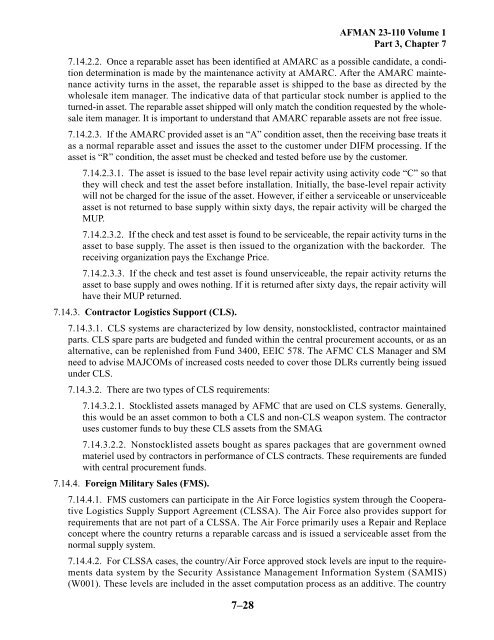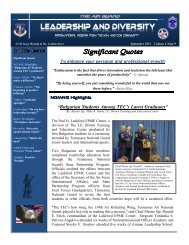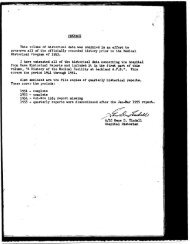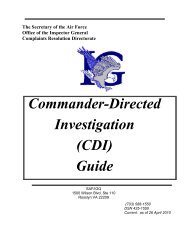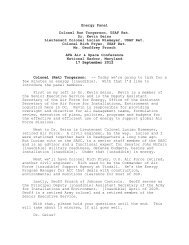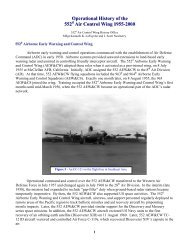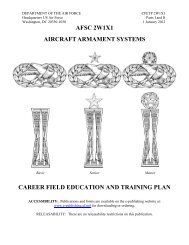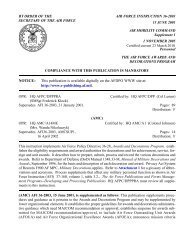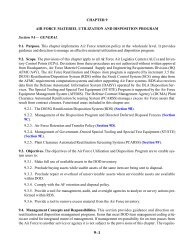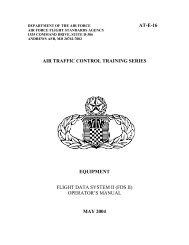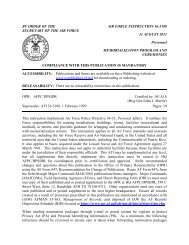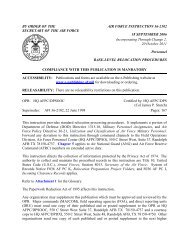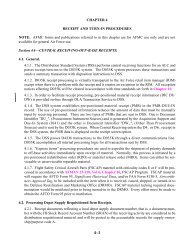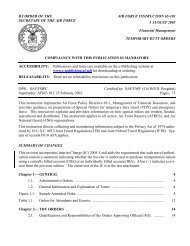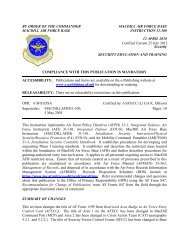Material support division, working capital fund - Air Force Link
Material support division, working capital fund - Air Force Link
Material support division, working capital fund - Air Force Link
Create successful ePaper yourself
Turn your PDF publications into a flip-book with our unique Google optimized e-Paper software.
7–28<br />
AFMAN 23-110 Volume 1<br />
Part 3, Chapter 7<br />
7.14.2.2. Once a reparable asset has been identified at AMARC as a possible candidate, a condition<br />
determination is made by the maintenance activity at AMARC. After the AMARC maintenance<br />
activity turns in the asset, the reparable asset is shipped to the base as directed by the<br />
wholesale item manager. The indicative data of that particular stock number is applied to the<br />
turned-in asset. The reparable asset shipped will only match the condition requested by the wholesale<br />
item manager. It is important to understand that AMARC reparable assets are not free issue.<br />
7.14.2.3. If the AMARC provided asset is an “A” condition asset, then the receiving base treats it<br />
as a normal reparable asset and issues the asset to the customer under DIFM processing. If the<br />
asset is “R” condition, the asset must be checked and tested before use by the customer.<br />
7.14.2.3.1. The asset is issued to the base level repair activity using activity code “C” so that<br />
they will check and test the asset before installation. Initially, the base-level repair activity<br />
will not be charged for the issue of the asset. However, if either a serviceable or unserviceable<br />
asset is not returned to base supply within sixty days, the repair activity will be charged the<br />
MUP.<br />
7.14.2.3.2. If the check and test asset is found to be serviceable, the repair activity turns in the<br />
asset to base supply. The asset is then issued to the organization with the backorder. The<br />
receiving organization pays the Exchange Price.<br />
7.14.2.3.3. If the check and test asset is found unserviceable, the repair activity returns the<br />
asset to base supply and owes nothing. If it is returned after sixty days, the repair activity will<br />
have their MUP returned.<br />
7.14.3. Contractor Logistics Support (CLS).<br />
7.14.3.1. CLS systems are characterized by low density, nonstocklisted, contractor maintained<br />
parts. CLS spare parts are budgeted and <strong>fund</strong>ed within the central procurement accounts, or as an<br />
alternative, can be replenished from Fund 3400, EEIC 578. The AFMC CLS Manager and SM<br />
need to advise MAJCOMs of increased costs needed to cover those DLRs currently being issued<br />
under CLS.<br />
7.14.3.2. There are two types of CLS requirements:<br />
7.14.3.2.1. Stocklisted assets managed by AFMC that are used on CLS systems. Generally,<br />
this would be an asset common to both a CLS and non-CLS weapon system. The contractor<br />
uses customer <strong>fund</strong>s to buy these CLS assets from the SMAG.<br />
7.14.3.2.2. Nonstocklisted assets bought as spares packages that are government owned<br />
materiel used by contractors in performance of CLS contracts. These requirements are <strong>fund</strong>ed<br />
with central procurement <strong>fund</strong>s.<br />
7.14.4. Foreign Military Sales (FMS).<br />
7.14.4.1. FMS customers can participate in the <strong>Air</strong> <strong>Force</strong> logistics system through the Cooperative<br />
Logistics Supply Support Agreement (CLSSA). The <strong>Air</strong> <strong>Force</strong> also provides <strong>support</strong> for<br />
requirements that are not part of a CLSSA. The <strong>Air</strong> <strong>Force</strong> primarily uses a Repair and Replace<br />
concept where the country returns a reparable carcass and is issued a serviceable asset from the<br />
normal supply system.<br />
7.14.4.2. For CLSSA cases, the country/<strong>Air</strong> <strong>Force</strong> approved stock levels are input to the requirements<br />
data system by the Security Assistance Management Information System (SAMIS)<br />
(W001). These levels are included in the asset computation process as an additive. The country


